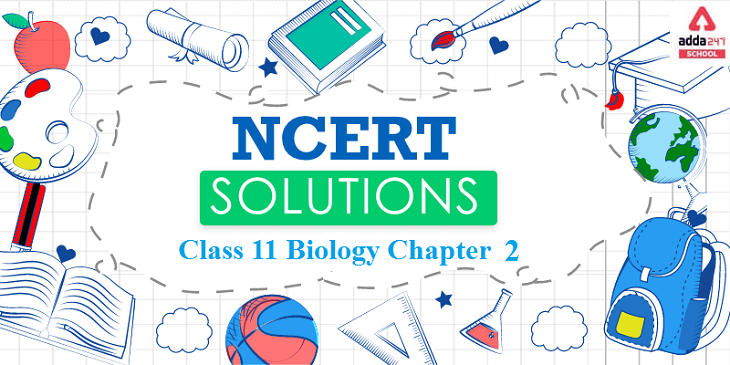Table of Contents
NCERT Solutions for Class 11 Biology Chapter 2 in English
Adda 247 provides NCERT Solutions for Class 11 Biology Chapter 2 which is for the students who want to go ahead in life and achieve great marks in their examinations. The NCERT Solutions for Class 11 Biology Chapter 2 are provided by the teachers who are experts in their subjects. The solutions are set according to the rules formulated by the NCERT and in the language that can be understood by every student. By reading the solutions students can build up a strong base easily. The NCERT class 11 Biology solutions cover chapters 1 to 22 with the important questions and the answers in a detailed way.
Examinations can be threatening for some people, a proper learning of the concepts is the key to crack the examination. Students rely on the solutions of the NCERT provided by Adda 247. The solutions are formulated by the experts of the subjects who have tremendous knowledge in their subjects.
These NCERT Solutions help the students to get familiarized with the textbooks. The students can access the solutions anywhere while browsing the web easily. The solutions are very precise and accurate.
NCERT Solutions for Class 11 Biology Chapter 2 – Biological Classification
NCERT Solutions for Class 11 Biology Chapter 2 provides information about Biological classification. Biological classification is the process by which scientists group living organisms. Organisms are classified based on how similar they are. Historically, the similarity was determined by examining the physical characteristics of an organism but modern classification uses a variety of techniques including genetic analysis.
Organisms are classified according to a system of seven ranks:
1, Kingdom, 2. Phylum, 3. Class, 4. Order, 5. Family, 6. Genus, 7. Species
[sso_enhancement_lead_form_manual title=”Download Full PDF of Class 11 Biology Chapter 2 ” button =”Download Now” pdf =”/jobs/wp-content/uploads/2021/06/09110906/English-chapter-2.pdf”]
key Features of the NCERT Solutions for Class 11 Biology Chapter 2- Biological Classification
NCERT Solutions for Class 11 Biology Chapter 2 have been answered based on the important information on the question.
- The columns are used wherever necessary.
- Solutions are solved point-wise and accurately answered point to point.
NCERT Solutions for Class 11 Biology Chapter 2 Important Questions
Question 1. Discuss how classification systems have undergone several changes over a period of time.
Answer:
- The first classification was given by Aristotle to classify herbs, shrubs, and trees. Animals were classified on the presence or absence of red blood cells.
- Linnaeus proposed a two-kingdom classification with two kingdoms, Plantae and Animalia.
- Ernst Haeckel separated unicellular eukaryotes in kingdom Protista and proposed three
kingdom classification.
- Four kingdom classification was given by Copeland where a kingdom Monera was added.
- RH Whittaker gave a five-kingdom classification where the kingdoms were, Monera, Protista, Fungi, Plantae, and Animalia.
- Stanley, later on, described viruses, viroids, etc.
Question 2. State two economically important uses of: (a) heterotrophic bacteria
(b) archaebacteria
Answer:
- a) Heterotrophic bacteria: The bacteria that survive by deriving energy from organic matter from other sources. Bacteria such as Lactobacillus helps in the production of curd and cheese from the milk. Pseudomonas help in decomposing organic matter and the formation of the humus. Some bacteria such as Streptomyces, Bacillus help in the formation of antibiotics. Rhizobium, Acetobacter help in nitrogen fixation.
- b) Archaebacteria: They are the group of prokaryotes that survive in a very harsh and hostile environment. They are used in many applications of biotechnology. Methane gas is produced from the dung of the ruminants by some methanogens. They are also involved in the production of biogas and sewage treatment.
Question 3. What is the nature of cell walls in diatoms?
Answer: The cell walls are constructed by diatoms possess Frustule which has two thin overlapping shells fitted into one another such as a soap box. The walls are made up of silica which gets deposited as diatomaceous earth when they die.
Question 4. Find out what do the terms ‘algal bloom’ and ‘red-tides’ signify.
Answer: Algal bloom, as the name suggests is the increase in population of algae or blue green algae in water by enrichment of the nutrients which discolours the water body. This increases the biological oxygen demand (BOD) causing death of the aquatic animals because of suffocation. Red tide occurs due to algal blooms in which the number of algae increases to discolour the aquatic bodies.
Question 5. How are viroids different from viruses?
Answer:
(i) Virus consists of protein encapsulation the genetic material whereas the viroids are free RNA particles.
(ii) Viroids have a smaller size than virus.
(iii)Virus infects all types of organisms while viroids can only infect plants
Question 6. Describe briefly the four major groups of Protozoa.
Answer:
(i) Amoeboid protozoans: They use pseudopodia for movement such as Entamoeba.
(ii) Flagellated protozoans: They have flagella for locomotion such as Trypanosoma.
(iii)Ciliated protozoans: They possess numerous cilia for coordinated movement of organism such as Paramoecium.
(iv)Sporozoans: They cannot move but are carried around by the flow of fluids. They are parasites such as Plasmodium.
Question 7. Plants are autotrophic. Can you think of some plants that are partially
heterotrophic
Answer: Plants are autotrophs as they can synthesize their own food by the process of photosynthesis because of the presence of green pigments. Some plants such as insectivores are partially heterotrophic derive their nutrition by capturing insects to supplement their diet with nitrogen from insects such as Pitcher plant (Nepenthes), venus fly trap.
Question 8. What do the terms phycobiont and mycobiont signify?
Answer: Algae lives with fungi in a symbiotic association known as lichens, where both of them are benefitted from each other. The algae prepares food for fungi while fungus provides shelter to the algae and absorbs water and nutrients from the soil. The algal portion is known is Phycobiont whereas the fungal portion is Mycobiont.
Question 10. What are the characteristic features of Euglenoids?
Answer: The characteristics are as follows:
(i) Unicellular protists found in freshwater.
(ii) Pellicle is present instead of cell wall.
(iii) Presence of two flagella on the anterior end of the body.
(iv) Light sensitive eye spot is present.
(v) Presence of photosynthetic pigments such as chlorophyll and are able to prepare their own food. They can also act as heterotrophs by capturing small aquatic organisms.
(vi) Presence of plant and animal-like features.
Question 11. Give a brief account of viruses with respect to their structure and nature of genetic material. Also name four common viral diseases.
Answer: Viruses are small microscopic, infectious nucleoprotein particles that are able to infect all living organisms. The virus has a protein encapsulated genetic material. Most of the viruses have single-stranded RNA as the genetic material. The virus infecting the bacteria are known as bacteriophages. They have double-stranded DNA as the genetic material. The protein coat is known as a capsid made up of capsomere subunits which are arranged in helical or polyhedral fashion.
Viral diseases are Small pox, mumps, influenza and so on.
FAQs on NCERT Solutions for Class 11 Biology Chapter 2
What are the advantages of referring NCERT Solutions for class 11 Biology chapter 2?
Students referring to the NCERT Solutions by Adda 247 find the solutions helpful during the exams. The solutions are prepared by the experts in an interactive manner keeping in mind the students. The students’ perspective is kept in mind while preparing the solutions. It helps in completing the syllabus on time and also provides notes for the revision prior to the exam.
What are the advantages of referring NCERT in competitive exams like JEE and AIPMT?
Most of the competitive exams like NEET, JEE etc. follow the basic NCERT books for designing their question papers. NCERT serves as the base for every book prepared for NEET and JEE. The competitive exams are based on the CBSE syllabus applied in XI and XII classes and NCERT books strictly follow CBSE syllabus. In addition to this, NCERT books play an important role in clearing out the theoretical concepts. Every topic given in NCERT books is explained in such a way to help students make their basics and fundamentals strong and clear.
How to read NCERT books more efficiently?
Given below are the important points which must be followed while reading the NCERT books in an efficient manner:
Go through each topic thoroughly by understanding the meaning and significance of each line mentioned in that particular topic.
Ask your teacher if any doubts.
Note down the important topics to revise at the time of examination.
Solve all the exercise questions given at the end of each chapter. These questions are important for understanding the concepts in a better way.
Is it mandatory to solve all the NCERT questions mentioned at the end of each chapter?
The questions and answers mentioned in NCERT textbooks at the end of each chapter are quite important not only for examination but also for understanding the concepts in a better way. These questions aim to test the students’ understanding and learning over the topics that they have learned in the chapter.
Solving the NCERT exercise problems will help to
- clear all the concepts and formulae you learned in a chapter
- get comfortable with different types of questions that might be asked in exams
- get enough practice which is key to succeed in Mathematics exam
- improve your accuracy and speed
What are the important concepts covered in the Chapter 2 of NCERT Solutions for Class 11 Biology?
The concepts involved are –
2.1 – Kingdom Monera
2.2 – Kingdom Protista
2.3 – Kingdom Fungi
2.4 – Kingdom Plantae
2.5 – Viruses, Viroids, Prions And Lichens
These concepts are created by the faculty at Adda 247. The solutions are available at Adda 247 in the PDF format which can be downloaded by the students.


 NEET Chemistry Syllabus 2025, Check Clas...
NEET Chemistry Syllabus 2025, Check Clas...
 NEET UG 2025 News: Check NEET Exam Mode
NEET UG 2025 News: Check NEET Exam Mode
 CBSE Board Exams 2025 Latest News- Recen...
CBSE Board Exams 2025 Latest News- Recen...





























